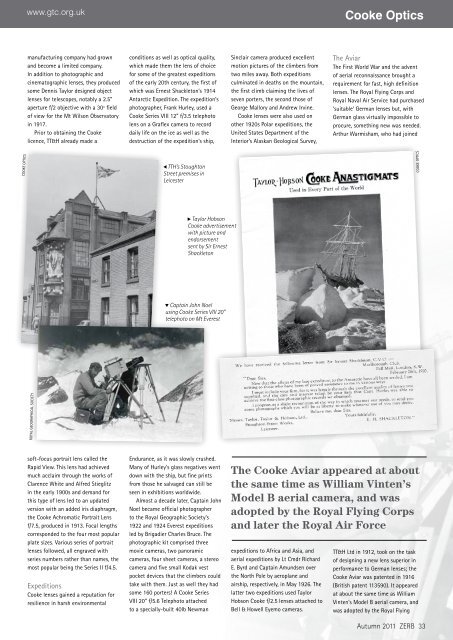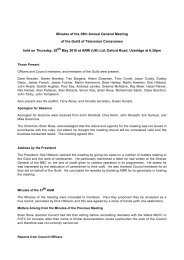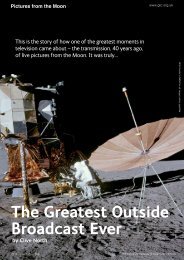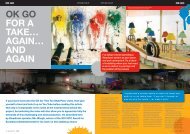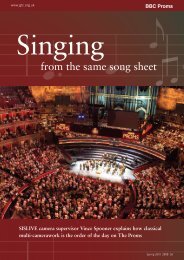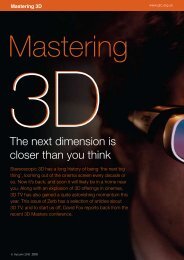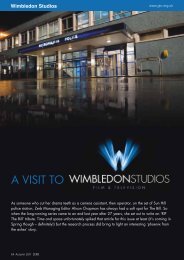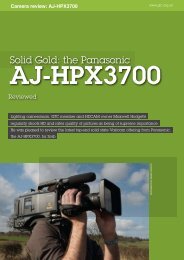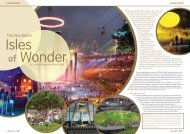Cooke Optics
Cooke Optics
Cooke Optics
Create successful ePaper yourself
Turn your PDF publications into a flip-book with our unique Google optimized e-Paper software.
www.gtc.org.uk<br />
<strong>Cooke</strong> <strong>Optics</strong><br />
manufacturing company had grown<br />
and become a limited company.<br />
In addition to photographic and<br />
cinematographic lenses, they produced<br />
some Dennis Taylor designed object<br />
lenses for telescopes, notably a 2.5”<br />
aperture f/2 objective with a 30º field<br />
of view for the Mt Wilson Observatory<br />
in 1917.<br />
Prior to obtaining the <strong>Cooke</strong><br />
licence, TT&H already made a<br />
conditions as well as optical quality,<br />
which made them the lens of choice<br />
for some of the greatest expeditions<br />
of the early 20th century, the first of<br />
which was Ernest Shackleton’s 1914<br />
Antarctic Expedition. The expedition’s<br />
photographer, Frank Hurley, used a<br />
<strong>Cooke</strong> Series VIII 12” f/3.5 telephoto<br />
lens on a Graflex camera to record<br />
daily life on the ice as well as the<br />
destruction of the expedition’s ship,<br />
Sinclair camera produced excellent<br />
motion pictures of the climbers from<br />
two miles away. Both expeditions<br />
culminated in deaths on the mountain,<br />
the first climb claiming the lives of<br />
seven porters, the second those of<br />
George Mallory and Andrew Irvine.<br />
<strong>Cooke</strong> lenses were also used on<br />
other 1920s Polar expeditions, the<br />
United States Department of the<br />
Interior’s Alaskan Geological Survey,<br />
The Aviar<br />
The First World War and the advent<br />
of aerial reconnaissance brought a<br />
requirement for fast, high definition<br />
lenses. The Royal Flying Corps and<br />
Royal Naval Air Service had purchased<br />
‘suitable’ German lenses but, with<br />
German glass virtually impossible to<br />
procure, something new was needed.<br />
Arthur Warmisham, who had joined<br />
COOKE OPTICS<br />
TTH’s Stoughton<br />
Street premises in<br />
Leicester<br />
COOKE OPTICS<br />
Taylor Hobson<br />
<strong>Cooke</strong> advertisement<br />
with picture and<br />
endorsement<br />
sent by Sir Ernest<br />
Shackleton<br />
Captain John Noel<br />
using <strong>Cooke</strong> Series VIII 20”<br />
telephoto on Mt Everest<br />
royal geographicAL society<br />
soft-focus portrait lens called the<br />
Rapid View. This lens had achieved<br />
much acclaim through the works of<br />
Clarence White and Alfred Stieglitz<br />
in the early 1900s and demand for<br />
this type of lens led to an updated<br />
version with an added iris diaphragm,<br />
the <strong>Cooke</strong> Achromatic Portrait Lens<br />
f/7.5, produced in 1913. Focal lengths<br />
corresponded to the four most popular<br />
plate sizes. Various series of portrait<br />
lenses followed, all engraved with<br />
series numbers rather than names, the<br />
most popular being the Series II f/4.5.<br />
Expeditions<br />
<strong>Cooke</strong> lenses gained a reputation for<br />
resilience in harsh environmental<br />
Endurance, as it was slowly crushed.<br />
Many of Hurley’s glass negatives went<br />
down with the ship, but fine prints<br />
from those he salvaged can still be<br />
seen in exhibitions worldwide.<br />
Almost a decade later, Captain John<br />
Noel became official photographer<br />
to the Royal Geographic Society’s<br />
1922 and 1924 Everest expeditions<br />
led by Brigadier Charles Bruce. The<br />
photographic kit comprised three<br />
movie cameras, two panoramic<br />
cameras, four sheet cameras, a stereo<br />
camera and five small Kodak vest<br />
pocket devices that the climbers could<br />
take with them. Just as well they had<br />
some 160 porters! A <strong>Cooke</strong> Series<br />
VIII 20” f/5.6 Telephoto attached<br />
to a specially-built 40lb Newman<br />
The <strong>Cooke</strong> Aviar appeared at about<br />
the same time as William Vinten’s<br />
Model B aerial camera, and was<br />
adopted by the Royal Flying Corps<br />
and later the Royal Air Force<br />
expeditions to Africa and Asia, and<br />
aerial expeditions by Lt Cmdr Richard<br />
E. Byrd and Captain Amundsen over<br />
the North Pole by aeroplane and<br />
airship, respectively, in May 1926. The<br />
latter two expeditions used Taylor<br />
Hobson <strong>Cooke</strong> f/2.5 lenses attached to<br />
Bell & Howell Eyemo cameras.<br />
TT&H Ltd in 1912, took on the task<br />
of designing a new lens superior in<br />
performance to German lenses; the<br />
<strong>Cooke</strong> Aviar was patented in 1916<br />
(British patent 113590). It appeared<br />
at about the same time as William<br />
Vinten’s Model B aerial camera, and<br />
was adopted by the Royal Flying<br />
Autumn 2011 ZERB 33


